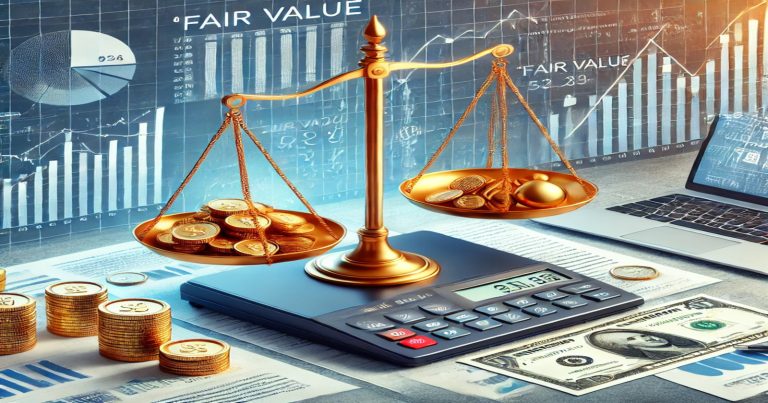As a statistical approach based on the fair value method of share valuation, it informs the true value of the stock of the company. The cash flow valuation is fundamental in finance and is integral to investors, analysts, and accountants when deciding the actual value of a share. The technique is crucial for share investment, mergers, and acquisitions. While market value is subject to changes depending on supply and demand, fair value provides a better financial position of the company. Knowledge of fair value guarantees sound investment choices and enhanced financial planning.
Most investors employ the fair value approach to valuing shares to ascertain whether a stock is overvalued or undervalued. It also applies to financial reporting and taxation. In this article, we will cover valuation of shares, how to derive fair value, what influences it, and how it applies in stock investing and futures trading.
What is Valuation of Shares?
Share valuation is determining the value of a company’s stock. Share valuation is an integral part of investment and decision-making in financial matters. Enterprises, investors, and analysts perform various methods of valuation to get the appropriate share price. The process assists in making profitable investment and financial disclosures
Why is Share Valuation Important?
- Assists investors in making a decision to purchase or sell shares.
- Helps in firm mergers, acquisitions, and restructuring.
- Needed for tax and financial reporting.
- Offers a glimpse into a firm’s financial well-being.
Common Share Valuation Methods
- Market Value Method – Derived from stock exchange prices.
- Intrinsic Value Method – Analyzes a firm’s fundamentals.
- Book Value Method – Applies net assets per share.
- Fair Value Method – Calculates the actual value of a share.
What is Fair Value Method of Valuation of Shares?
The fair value method of share valuation approximates the actual value of a stock according to financial accounts, market and industry conditions, and trends in the market. It is immune to market rumor and investor feeling.
Key Aspects of Fair Value Method
- Fundamental Analysis based on – Utilizes earnings, assets, and liabilities.
- Eliminates Market Fluctuations – It takes into account intrinsic worth, unlike market value.
- Applied in Accounting & Taxation – Businesses apply fair value in financial reporting.
- Significant for Investors – Facilitates long-term investment choices.
This approach provides a true valuation that captures the firm’s true financial position.
Calculating Fair Value Method of Valuation of Shares
The fair value of shares is calculated using different techniques. The most common methods include discounted cash flow (DCF), price-to-earnings ratio (P/E), and asset-based valuation.
Factors Affecting Fair Value
There are several factors that affect the fair value of a share. Knowing them aids in sounder investment choices.
Major Factors Affecting Fair Value
- Earnings & Revenue Growth – The higher the earnings, the higher the fair value.
- Economic Conditions – Interest rates, inflation, and GDP have their say in valuation.
- Industry Trends – Competitive positions influence fair value.
- Market Sentiment – Investor sentiment indirectly impacts valuation.
- Company Assets & Liabilities – Increasing assets and decreasing liabilities result in increased fair value.
By analyzing these factors, investors can estimate the fair value accurately.
Value Method of Valuation of Shares Example
To understand fair value better, let’s take an example of Company ABC.
Example Calculation
- Company ABC Earnings = $10 million
- Shares Outstanding = 1 million
- P/E Ratio of Industry = 15
Using the P/E method:
Fair Value per Share = Earnings per Share × Industry P/E Ratio
Fair Value = ($10M / 1M) × 15 = $150 per share
This shows how the fair value method of valuation of shares helps in estimating stock worth.
Fair Value in Stock Investing
When a stock trades at a lower price than fair value, it is a bargain, and if a stock trades higher than its fair value, it can be a source of potential loss. Fair value is extensively used by individual investors and institutional traders to make investment decisions. This practice helps investors resist short-term market movements and use the intrinsic value of a stock.
How Fair Value Helps Investors
- Steers Clear of Overpriced Stocks – Many stocks are overpriced because of market hype and speculation This prevents investors from overpaying for such stocks at unsustainable levels, thus minimizing the risk of losses.
- Picks Out Undervalued Stocks – Stocks trading beneath their reasonable value often provide solid buy opportunities. Buy such stocks at a discount, and reap higher returns when the stock price corrects over time.
- It Promotes Long-Term Investments – Long-term investors, who favor fair-value analysis, can justify holding stocks with sound financial fundamentals and future growth opportunities.
- Improves Portfolio Management – Understanding fair value helps investors distribute their capital efficiently, optimizing risk and return when building a diversified investment portfolio.
- Fundamental Analysis – Fundamental analysis relies on value to determine if an investor should add a stock to their portfolio.
Utilizing fair value approach prevents speculation-based risks and enables investors to take informed decisions and create a robust investment portfolio aimed at long-term profits.
Fair Value in Futures Trading
In futures trading, fair value is an important concept to consider when considering the right pricing of contracts. Futures traders compare an asset’s fair value with the real market price of the futures contract to find trading opportunities. Through the use of fair value, traders are capable of making proper decisions regarding entering or exiting positions in the futures market. Fair value in futures trading is most significant in arbitrage, speculation, and risk management.
Role of Fair Value in Futures Trading
- Price Movement Predictions – Fair value provides futures traders with the information necessary to know whether contracts are being sold above/ below theoretical value. Which is helpful in determining your buying or selling of the futures contracts.
- Assists Arbitrageurs – Arbitrage traders look for risk-free trading opportunities, which they identify through fair value. They can buy or sell the contract and take advantage of price differences (the contract will be at or under its fair value).
- Impacts Hedging Strategies – Fair value is used by businesses & investors to hedge against market risks. Such analysis allows traders to make better hedging decisions through the comparison of fair value with current market prices.
- Backed by Institutional Investors – The large financial institutions use fair value calculations while taking decisions for profitable futures trades to hedge portfolio risks.
- Offers Market Stability – Futures market remains efficient by fair value pricing measures leading to less price distortions and speculative bubbles.
In view of fair value, futures traders and investors can make better trading decisions in futures and futures options markets, which enhances the deployment of trading strategies and makes them more profitable.
Relevance to ACCA Syllabus
Valuation of shares under the fair value method is a much-needed concept in ACCA’s Financial Reporting (FR) and Strategic Business Reporting (SBR) papers. In particular, IFRS defines fair value under IFRS 13 (Fair Value Measurement), which is essential to prepare financial statements. In financial reporting, asset valuation, and mergers & acquisitions, ACCA students are required to apply fair value measurement techniques.
Fair Value Method of Valuation of Shares ACCA Questions
Q1: Which IFRS standard governs the fair value method of valuation of shares?
A) IFRS 9
B) IFRS 15
C) IFRS 13
D) IFRS 16
Ans: C) IFRS 13
Q2: What is the main purpose of using the fair value method in financial reporting?
A) To estimate historical cost
B) To determine market speculation
C) To provide an accurate valuation of financial instruments
D) To replace book value with cash flows
Ans: C) To provide an accurate valuation of financial instruments
Q3: Under IFRS 13, which of the following is NOT a level in the fair value hierarchy?
A) Level 1 – Quoted prices in active markets
B) Level 2 – Observable inputs
C) Level 3 – Unobservable inputs
D) Level 4 – Historical cost method
Ans: D) Level 4 – Historical cost method
Q4: Fair value measurement in financial reporting is most commonly used for which type of assets?
A) Intangible assets
B) Inventory
C) Financial instruments
D) Plant and machinery
Ans: C) Financial instruments
Relevance to CMA (US) Syllabus
To believe this, just look at the US CMA (Certified Management Accountant) syllabus where fair value measurement is part of Part 1: Financial Reporting, Planning, Performance and Control. It is used extensively for investment analysis, financial modeling, and risk assessment.
Fair Value Method of Valuation of Shares US CMA Questions
Q1: In US CMA, the fair value method is primarily used for evaluating which type of financial decision?
A) Cost minimization
B) Capital investment valuation
C) Tax planning
D) Budgeting strategies
Ans: B) Capital investment valuation
Q2: The fair value method of valuation of shares is important in financial reporting because:
A) It ensures valuation based on future cost projections
B) It provides an accurate measure of the intrinsic value of assets
C) It focuses solely on past financial statements
D) It eliminates the need for depreciation calculations
Ans: B) It provides an accurate measure of the intrinsic value of assets
Q3: Which of the following is an example of a Level 1 fair value input?
A) Market price of publicly traded shares
B) Internal company valuation models
C) Management’s estimate of an asset’s future value
D) Adjusted book values
Ans: A) Market price of publicly traded shares
Q4: In fair value measurement, Level 3 inputs refer to:
A) Quoted market prices
B) Observable market data
C) Unobservable inputs and assumptions
D) Historical cost data
Ans: C) Unobservable inputs and assumptions
Relevance to CPA (US) Syllabus
The fair value topics come up repeatedly in the US CPA (Certified Public Accountant) exam, so read on to learn about them ahead of the Financial Accounting and Reporting (FAR) test. The requirement for fair value measurement is mandated under US GAAP (ASC 820: Fair Value Measurement). CPAs are required to use fair value methods in financial statements, mergers & acquisitions, and business combinations.
Fair Value Method of Valuation of Shares US CPA Questions
Q1: Under US GAAP, which accounting standard defines fair value measurement?
A) ASC 606
B) ASC 820
C) ASC 740
D) ASC 350
Ans: B) ASC 820
Q2: What is the primary purpose of using fair value in financial statements under US GAAP?
A) To record assets at historical cost
B) To adjust tax liabilities
C) To provide a market-based measurement of asset value
D) To estimate book value based on past performance
Ans: C) To provide a market-based measurement of asset value
Q3: Which financial instruments are most commonly valued using fair value methods?
A) Cash equivalents
B) Intangible assets
C) Long-term investments
D) Marketable securities
Ans: D) Marketable securities
Q4: When fair value is measured using unobservable inputs, it is classified under which hierarchy level?
A) Level 1
B) Level 2
C) Level 3
D) Level 4
Ans: C) Level 3
Relevance to CFA Syllabus
The Financial Reporting and Analysis (FRA) section of the Chartered Financial Analyst (CFA) programs includes fair value measurement. The CFA charterholders are requisites for executing fair value approaches to equity valuation, fixed income valuation, financial modeling, and investment making decisions. Fair value for the financial statements is also dealt in IFRS and US GAAP.
Fair Value Method of Valuation of Shares CFA Questions
Q1: How is fair value different from intrinsic value in investment analysis?
A) Fair value is based on past transactions, while intrinsic value is forward-looking
B) Fair value considers market-based inputs, while intrinsic value is based on company fundamentals
C) Fair value is determined by historical cost, while intrinsic value depends on market fluctuations
D) Fair value and intrinsic value are always the same in investment decisions
Ans: B) Fair value considers market-based inputs, while intrinsic value is based on company fundamentals
Q2: In CFA Level 1, fair value is most relevant in which area of financial analysis?
A) Portfolio Management
B) Fixed Income Valuation
C) Financial Reporting and Analysis
D) Behavioral Finance
Ans: C) Financial Reporting and Analysis
Q3: The fair value method of valuation is particularly useful in:
A) Corporate tax planning
B) Mergers and acquisitions
C) Short-term budgeting
D) Inventory management
Ans: B) Mergers and acquisitions
Q4: Which approach is most commonly used to determine fair value under CFA financial modeling?
A) Discounted Cash Flow (DCF)
B) Book Value Method
C) Net Present Value (NPV)
D) Accrual Accounting
Ans: A) Discounted Cash Flow (DCF)


